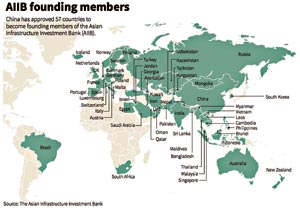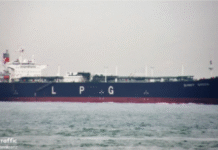Countries from five continents formally signed up on June 29 to the Asian Infrastructure Investment Bank—a potential rival to the Washington-based World Bank. Australia, followed by 49 other founding members including Bangladesh, was the first country to sign the articles of association creating the AIIB’s legal framework at a ceremony in Beijing’s Great Hall of the People. Seven more Denmark, Kuwait, Malaysia, Philippines, Poland, South Africa and Thailand, are expected to do so by the end of the year. The bank will have a share capital of $100 billion, with $20 billion paid initially, the document showed.
The signing “is an embodiment of the concrete action and efforts made by all countries in the spirit of solidarity, openness, inclusion and cooperation”, Chinese President Xi Jinping said after the ceremony, adding “Now we are willing to listen to your views and proposals.” Following the ceremony, China’s President Xi Jinping welcomed the heads of delegations from the Bank’s 57 prospective founding members. In a statement the Treasurer’s office of Australia said: “All members will be directly involved in the direction and decision-making of the bank in an open and transparent manner.”
AIIB’s governance and guidance
Presumably, the statement was meant to address US concerns about the governance standards at the new institution, which is seen as spreading Chinese “soft power.” The AIIB has been viewed by some international development specialists as a rival to the World Bank and Asian Development Bank, and the United States and Japan—the world’s largest and third-largest economies, respectively—have expressed reservations and decided not to join.
Washington’s concerns are over transparency of the lender, which will fund infrastructure in Asia, as well as worries that a resurgent Beijing will use it to push its own geopolitical and economic interests. In Tokyo, Japan’s Chief Cabinet Secretary Yoshihide Suga said: “We hope the AIIB will play a role as a financial institution that contributes to Asia’s development while meeting standards of international institutions, including for its governance.
AIIB articles of association promise the bank will “be guided by sound banking principles in its operations” and ensure its operations comply with “policies addressing environmental and social impacts”. The articles of association simply specify that the bank’s president must come from the Asian region and will serve a maximum of two consecutive five-year terms. China says it is keeping the door open for anyone else who wants to join the multilateral institution, but the United States and Japan have not announced a change of heart. Japan said: “We’d like to watch it closely, including its actual operations.”
Apart from Australia and China, some of the countries which signed the agreement include Bangladesh, Brazil, Cambodia, Finland, France, Germany, India, Indonesia, Italy, Jordan, Nepal, Netherlands, New Zealand, Norway, Pakistan, Portugal, Republic of Korea, Russia, Saudi Arabia, Singapore, Spain, Sri Lanka, Sweden, Switzerland, Turkey, the U.A.E., and the U.K. etc. (vide map). Clearly the Bank, though initially focused on Asian infrastructure, is potentially global in character.
‘Example of constructive cooperation’
The National Institute of Public Finance and Policy in New Delhi said: “The AIIB is an example of constructive cooperation among emerging economies to increase the space available for infrastructure financing… It is a regional initiative and, therefore, fully complements global initiatives such as the New Development Bank [set up by the BRICS nations].”
According to an AIIB press statement, the Bank will be headquartered in Beijing, and will have an initial authorised capital stock of $100 billion. Reflecting regional character of the Bank, its regional members will be the majority shareholders, holding around 75 percent of shares. The AIIB is expected to become operational by the end of the year.
The AIIB was created in October 2014 by 21 countries, Bangladesh being one of them, led by China, to fund Asian energy, transport and infrastructure projects. Bangladesh will have to initially pay $132.1 million in five installments for its share of AIIB membership. Once the bank is functional, Dhaka will apply for project loans and technical assistance, said MA Mannan, state minister of Bangladesh for finance and planning, who flew to Beijing for the signing ceremony.
The Economic Relations Division believes that the terms and conditions of AIIB loans would be similar to those of ADB. At present, the ADB gives two types of loans: one which carries an interest rate of 2.5 percent and another linked to Libor, which is normally within the range of 4.5 to 5 percent. Presumably, AIIB loans would not be linked to Libor, may allow a longer period of repayment, and unlike the existing International Monetary Fund and World Bank, would not restrict lending on political considerations.
AIIB’s share holding
Beijing will be by far the largest AIIB shareholder at 30.34 percent, the articles of association posted on the website of China’s finance ministry showed. India is the second biggest at 8.4 percent with Russia third on 6.5 percent. Germany plans to take a 4.59 percent stake to become the fourth-biggest member after China, India and Russia. Korea is the fifth with 3.81 percent shareholding. Australia would contribute A$930 million ($719.36 million) over five years to become the institution’s sixth largest shareholder (3.76%). The next fourteen countries in order of high shareholding are France (3.44%), Indonesia (3.42%), Brazil (3.24%), U.K. (3.11%), Turkey (2.66%), Italy (2.62%), Saudi Arabia (2.59%), Spain (1.79%), Iran (1.61%), Thailand (1.45%), UAE (1.21%), Pakistan (1.05%), Netherlands (1.05%) and Philippines (1%).
The voting structure gives smaller members a slightly disproportionately larger voice, and a statement accompanying the articles said China will have 26.06 percent of the votes. China says it will not hold veto power within the AIIB, unlike the World Bank where the United States holds a limited veto.
Apart from backing the AIIB, China has also pledged billions of dollars to the Silk Road fund and the “One Belt, One Road” initiative, which are also aimed at funding infrastructure to increase trade and connectivity between Europe and Asia.
For Bangladesh, great opportunity exists by way of participation in the One Belt One Road initiative, in which it is already advanced by commitment to BCIM-EC, Kolkata to Kunming route via Bangladesh, Northeast India and Myanmar. Separate Chinese funding is already allocated for development of growth centres along that economic corridor. But progress on Bangladesh side, even by way of identification of needs and planning of necessary schemes has been lagging behind. The Indian side also appears to be going slow, preferring more to speed up the BIBN (Bhutan-India-Bangladesh-Nepal) transport corridor as well as water and energy cooperation.
BIBN and BCIM-EC
Albeit BIBN is beneficial to Bangladesh, and it is good to see its intergovernmental committees making progress setting an example of SAARC subregional cooperation, the BCIM-EC will open for us a potentially far larger arena of South-South Cooperation in terms of trade, tourism, technology exchange, enterprise and growth incentive leading to development of common market practices. It is therefore imperative that the intergovernmental exercises on BCIM-EC pick up speed and draw up plans for investment in infrastructures of extended and stable road communication and development of growth centres and access roads.
Indeed the supportive civil society exercises of the BCIM initiative had also been deliberately slow and simply advocacy data oriented. It is time to get down to project planning and identification of intergovernment agreements in relevant areas to be prepared and executed. As the funds are already there separately provided by China, there should be no hesitation in going ahead since the corridor route has been finalised by common consent taking into account sensitivity and security concerns of all parties.
For Bangladesh, an additional task in this regard is to seek agreement on a second route of BCIM by direct road link from Kunming to Chittagong via Myanmar and then on to Dhaka and Kolkata. In fact if agreed upon, this could be a sound project for application to AIIB by Bangladesh and Myanmar for development of appropriately wide stable road links in their respective parts. Such a road will reduce K to K road length by some 800 miles and will also allow a direct access to the proposed deep sea port in the Sonadia environment of Cox’s Bazar-Chittagong Comprehensive Development zone of Bangladesh. Subroutes by road and rail could also be developed from the Cox’s Bazar-Chittagong zone to Northeast India via border towns in Khagrachhari, Feni, Comilla and Sylhet districts to counterparts in Tripura, Assam and Meghalaya states of India.
Whither deep sea port?
Bangladesh government has been sitting on the proposal for building Sonadia deep sea port by the Chinese as a China-Bangladesh project or as a multilateral venture involving other interested countries like India or U.S.A. (who have not shown interest) and/or U.A.E. who have also separately shown interest. One wonders if two very large power plant projects could be awarded to two Indian private companies without tender, why the Sonadia deep sea port could not be negotiated with a Chinese company with or without other partners and with or without tender?
Meanwhile, the Japanese have started working on an alternative site in the same Sonadia environment, by converting its proposed coal terminal project at Matarbari into a deep sea port project. Whichever site Bangladesh government may award to whichever party for deep sea port development, it is important to back it up by linkage with BCIM Chittagong-Kunming Road link. Before the AIIB becomes operative by the end of the year, Bangladesh should be ready to apply for suitable projects including BCIM Chittagong to Kunming road link. Our sure road to prosperity lies in joining the Belt and Road initiative by the Chittagong to Kunming road and a deep sea port in the Cox’s Bazar-Chittagong belt for sea-link of that road.
Source: Weekly Holiday










